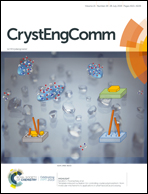Fluorescence response of cruciform D–π–A–π–D phenothiazine derivatives to mechanical force†
Abstract
Two cruciform D–π–A–π–D phenothiazine derivatives with two ester groups as electron-withdrawing moieties (i.e., EPTD and BPTD, with ethyl and butyl groups, respectively) were synthesized, and their responses to mechanical force stimuli were investigated. EPTD was found to have two polymorphs, namely, EPTD-Y and EPTD-R, with yellow and orange-red fluorescence, respectively. Single-crystal analysis illustrated that strong π-stacking affirmed by a short interplanar distance of 2.98 Å existed in the EPTD-Y crystal, which caused a large red-shift of 72 nm in the absorption spectrum. Meanwhile, although the π-stacking distance reached 3.74 Å, the electrostatic attraction between ester and phenothiazine moieties as an acceptor and donor, respectively, existed in the EPTD-R crystal, which may be responsible for its long emission wavelength. EPTD-R maintained its π-stacking after applying a mechanical force stimulus because its absorption and emission bands only slightly shifted. A fluorescence change from yellow to red occurred for the EPTD-Y crystal after grinding. The spectral results suggested that similar π-stacking existed in EPTD-R and EPTD-Y ground powders and was identical to that in the EPTD-R crystal. In addition, the BPTD crystal emitted green fluorescence due to weak π-stacking induced by a large stacking distance of 4.15 Å. Interestingly, it also changed its fluorescence into red after grinding because of the presence of π-stacking similar to that of the EPTD-R ground solid. Thus, π-stacking can be determined in three amorphous solids.



 Please wait while we load your content...
Please wait while we load your content...